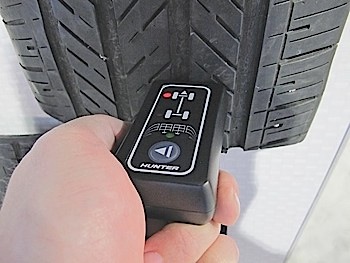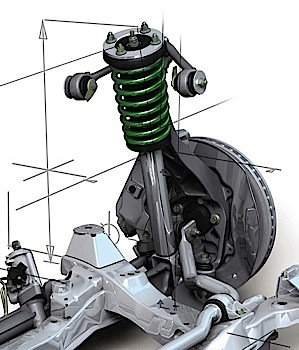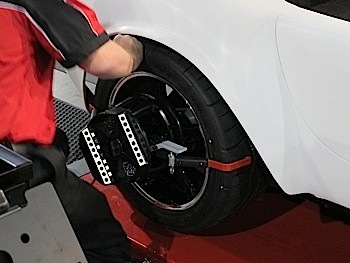1. CHECKING SELF- CALIBRATING STEERING ANGLE SENSORS
Self-calibrating steering angle sensors use inputs from the accelerometers to determine if the vehicle is traveling straight and resets the steering angle sensor. But, on most of these systems, some enabling criteria must be met, like a minimum speed and a defined amount of steering angle. This is why it is always a good idea to test drive a car after an alignment. It is always a good idea to perform one lock-to-lock turn before leaving the alignment bay.

2. DON’T FORGET THE TIRES
Tires are not perfect! Like every part on the car, tires and wheels are made within tolerances. These tolerances include runout and radial force variation. The changes in uniformity and stacked tolerances in the tire and wheel can cause a steering pull.
You can try rotating the tires to cancel out the pull or at least move the worst tire to a non-steering axle. But, during the next rotation the pull could return.
Some balancers simulate how the wheel actually performs on the vehicle by applying force over the entire tire/rim assembly. With its patented sensors, Hunter’s GSP9700 balancer pinpoints the lowest point of a rim (for runout) and the stiff area of a tire’s sidewall under load (for radial force variation). Then the patented software automatically determines how the assembly can be match-mounted to offer the best ride quality.
The balancer can then look at the entire set and place the right tire with the right rim and assign the correct position so a pull can be canceled out.
3. INFLATION FIRST
When doing your pre-alignment inspection, always check tire inflation pressures because a low tire will pull. It’s also important to note tire sizes. A car will pull toward the side with the smallest tires or the side with wider tires. A wide tire offers greater rolling resistance than a narrower tire. Wide tires also tend to be more sensitive to road crown steer than narrower ones.

4. HITTING THE BULLSEYE
When doing an alignment, always aim for the midpoint or preferred setting within a range of acceptable specs. And when that isn’t possible, then make sure you’re at least within the range of acceptable specs.
Also, try to minimize cross-camber by keeping the side-to-side camber readings within half a degree of each other. If camber is not within half a degree side-to-side, it may create a steering pull.
If the wheels won’t align, or if the wheels on a vehicle with a “nonadjustable” suspension are out of range, then something is bent or worn and needs to be straightened or replaced. Don’t just set the toe and let it go. If camber is off the mark, find out why and see if it’s worth fixing. A weak or broken spring, a collapsed control arm bushing, a mislocated strut tower or engine cradle, or a bent strut or control arm can throw camber off as well as Steering Axis Inclination (SAI) to cause a steering pull.
As with rear toe, rear camber is also important on vehicles with independent rear suspensions. A sagging suspension (typically due to a weak or broken spring) will often cause a rear camber problem, so be sure to inspect the suspension carefully if rear camber is off.
5. FIGHTING THE CROWN
Steering pull that’s caused by road crown can sometimes be compensated by adding positive caster to the left front wheel compared to the right front. You don’t need much, just enough to offset the road crown which slopes to the right. The trick is to find the right amount of caster that keeps the vehicle going straight and keeps your customer happy.
If caster is out of range, check for worn strut or control arm bushings, a mislocated MacPherson strut tower or a bent lower control arm.
6. PROBLEM VEHICLES
The toughest alignment job is the “problem” vehicle that keeps coming back because it’s wearing out tires or isn’t steering straight no matter how you align the wheels.
Sometimes the real problem is undiagnosed collision damage, such as a bent strut, steering arm, control arm, mislocated strut tower, subframe or engine cradle that is affecting alignment. And as we said earlier, rear axle steer may be causing front toe wear, as well as a steering pull.
A problem vehicle may have misaligned structural members that position the front or rear suspension. Assembly line build tolerances have tightened considerably in recent years, but nobody is perfect. Mistakes are made, and the so-called plus or minus 1 mm build tolerance is more myth than reality in many instances.
7. TAKE NOTES
A service writer’s note to the technician should answer the following questions:
• Why does the vehicle require an alignment?
• Does it pull? Which way? When?
• What is the vehicle used for?
The service writer should include all relevant information. Never worry about writing too much.

8. INFORMATION BELONGS IN THE ALIGNMENT BAY
Back in the days of CD-ROM based information systems, if you had to look up torque specs of adjustment procedure, you might have had to look it up in a service manual that was always missing the years you really needed or you had to go to a computer in the front office to look up the information. With most modern alignment consoles, the service information is incorporated into the core operating software of the system. Most of these systems are PC based and allow you to go onto the internet to look for information and even order parts.
9. PRICE ALIGNMENTS FOR THE VEHICLE AND NOT A MENU
There have been dramatic changes in vehicle technology and suspension designs in just the last decade. From “net build” vehicles made with only front toe adjustments to cast aluminum control links, the alignment process has changed with the vehicles. It is up to you to price an alignment accordingly. Alignments are not loss leaders.
10. TEST DRIVE THE VEHICLE BEFORE IT’S RETURNED TO THE CUSTOMER
A simple test drive can reveal a lot of problems that might have been otherwise overlooked. Sure, test drives take time, but so do comebacks. Think of it as a final quality-control check.










